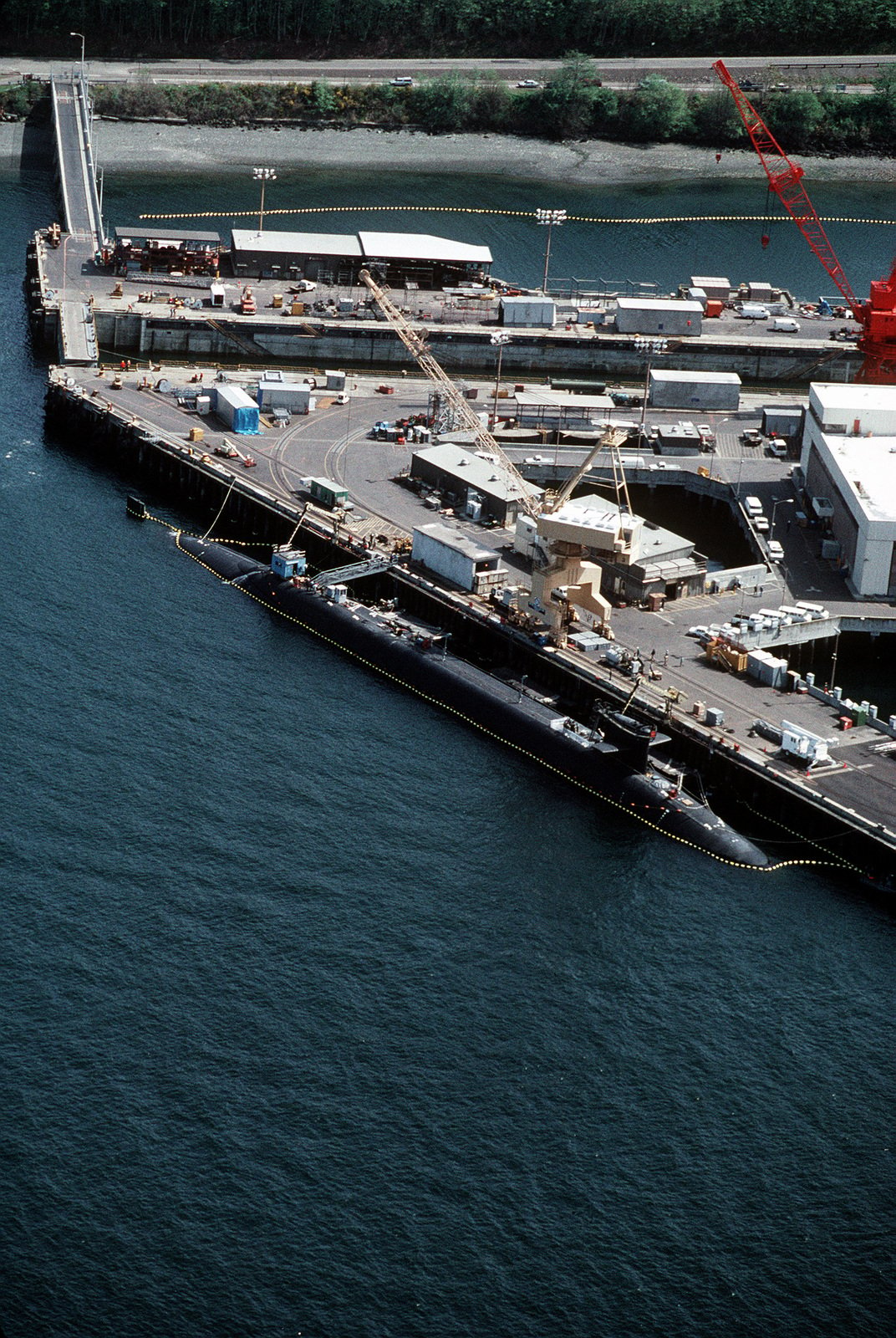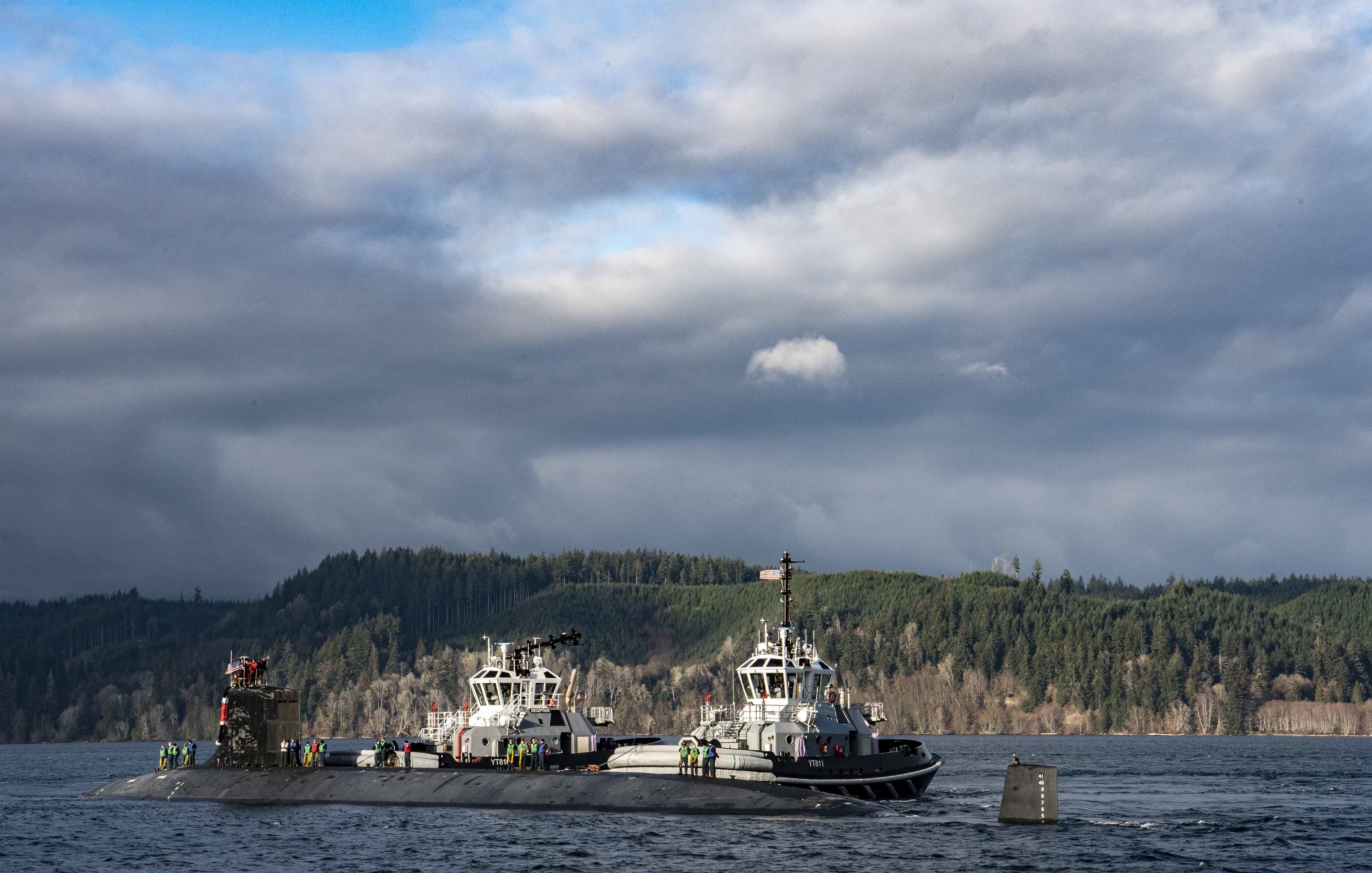Bangor Sub Base Washington - 47°43'27.84"N 122°43'12.17"W / 47.7244000°S 122.7200472°W / 47.7244000; -122.7200472 Coordinates: 47°43'27.84" N. 122°43'12.17" W / 47.7244000° N. 122.7200472°W / 47.7244000; -122.7200472
Naval Submarine Base Bangor and Mishawaka (left) and three other Natick-class tugboats USS Ohio (SSGN-726) leave dry dock at Delta Pier.
Bangor Sub Base Washington

Naval Submarine Base Bangor was a former U.S. Navy submarine base that merged with Naval Station Bremerton to form Naval Base Kitsap in 2004.
Uss Louisiana Gives A Shout Out To The Ragin' Cajuns
Bangor's history of supporting the Navy dates back to 1942 when it served as an ammunition depot in the Pacific Theater of Operations during World War II. To expand and establish a permanent naval base, the US Navy purchased 7,676 acres (3,100 hectares) of land on Hood Canal near Bangor, Washington, for approximately $18.7 million. US Army Ammunition Magazine. It was established for construction on June 5, 1944 and started working in January 1945.
From World War II, the Korean War, and the Vietnam War, until January 1973, the Bangor facility continued to serve as a US Navy ammunition depot responsible for exporting conversion weapons to other countries.
In 1973, the Navy announced the selection of Bangor as the home port for the first group of Ohio-class Tridt Fleet ballistic missile submarines. On February 1, 1977, the Tridt Foundation was officially opened. Naval Base Kitsap includes the Strategic Weapons Facility Pacific (SWFPAC), which provides storage, maintenance, missile assembly/testing, spare parts and nuclear warhead storage for UGM-133 Tridt II submarine-launched nuclear missiles.
This Tridt submarine base is the only one in the US. Pacific Fleet and Tridt Submarine Base in Kings Bay, Georgia, USA. The Atlantic Fleet was one.
File:uss Kentucky (gold) Returns To Naval Base Kitsap Bangor 160928 N Ud469 032.jpg
Marine Corps Security Forces Battalion Bangor protected cruise missile submarines and related infrastructure until it was designated as a company-sized special security unit in October 1978. The new team was named Naval Base Kitsap.
The U.S. Naval Submarine Base (SUBASE) is located on the eastern shore of Bangor Hood Canal. The foundation support units are located two nm from the water's edge. The original floating facilities at SUBASE Bangor included four separate pier complexes: the "KB" docks, the delta pier, the edge pier, and the explosives handling docks. Trident Submarines dock at South and North and South Marginal Pier and Delta Pier. They also operate an explosives handling dock and dry dock at Delta Pier. According to port authorities, submarines rarely have a cabin, and when they do, they only stay for a day or two. High decks are 20 feet higher, meaning the water level is lower. Lateral water depth varies from 45 feet at the north and south end standards, and from 60 to 115 feet at the Delta piers.
The original floating facilities at SUBASE Bangor included four separate pier complexes: the "KB" docks, the delta pier, the edge pier, and the explosives handling docks. Trident Submarines dock at South and North and South Marginal Pier and Delta Pier. They also operate an explosives handling dock and dry dock at Delta Pier. According to port authorities, submarines rarely have a cabin, and when they do, they only stay for a day or two. High decks are 20 feet higher, meaning the water level is lower. Lateral water depth varies from 45 feet at the north and south end standards, and from 60 to 115 feet at the Delta piers.

SUBASE Bangor has no facilities available. Shipping buoys are available near the KB docks. SUBASE Bangor 2,000 hp. power from YTB tugs and twin-screw 1,600 hp. owns commercial tugboats. Local authorities tell Bangor that pilots are used for all submarines. Flyers are available upon request from either Dirty Science at the Hood Canal entrance south of Bangor. If the officer in charge of the submarine has passed the Hood Canal Bridge once, the pilot has his choice. Testing is mandatory if registration assistance is required
Activists Arrested In Trident Submarine Blockade At Kitsap Bangor Naval Base
Southwesterly winds directly affect Bangor's dock facilities due to the location of Hood Canal. By viewing the channel relative to the adjacent topography, northeasterly across-the-channel winds are enhanced. If the wind speed reaches 25,000 tons, work at the explosives processing docks, Delta Drydock and magnetic deactivation facilities will be suspended. Wind is not the only problem for surface-based submarines, but it can cause waves to capsize their ships.
The KB docks are manned by gunners from the Undersea Engineering Station (NUWES) in Keyport. Bangor Pilots say that lines are doubled and dead lines and buoys are used to prevent excessive movement of moored vessels during strong periods of south-westerly winds. Most ships are moored inside the piers, but YTTs (Torpedo Recovery Boats - 135-140 feet long/1,600 tons) are moored outside the piers and are exposed to all conditions in Hood Canal.
The only threat identified at SUBASE Bangor is strong winds from the southwest across Hood Canal. Due to its low profile, the wind is not a direct threat to submarines. This could affect the ability of tugboats to work alongside submarines. It may also affect the performance of NUWES Keyport small vessels and YTTs using the KB Dock complex. As winds approach 50 kt, the Hood Canal Bridge is closed to vehicular traffic and remains open to reduce wind stress on the bridge structure. The floating bridge was partially destroyed by wind/wave during a very strong storm on February 13, 1979.
Southwest Delta Pier and KB Docks experience four to six heaves in high winds (up to 60 kt). If submarine entrances are closed, waves are not an immediate problem for submarines. However, if towed with a submarine, wave action can cause the submarine to be towed up and down with possible damage. To prevent such damage, normal towing operations are suspended in high wind conditions.
Rental Homes And Townhomes
Currents in Hood Canal, a partially enclosed basin, are driven mainly by waves. Northeasterly currents in the 1.0-1.2 kt range are common near SUBASE. Because of the steep slopes on both sides of the Hood Canal, heavy rains result in large runs. The extended current joins the tidal current during high tide, increasing the current speed to two kt. Local authorities say the submarines, which washed ashore south of Delta Pier during strong currents, had difficulty moving upstream and away from the pier. Southwesterly currents are typically in the 0.6 to 1 kt range.
Navy plans called for POLARIS FBM submarines to operate in the Pacific. With this in mind, the DoD announced on 23 April 1962 the selection of various POLARIS support locations in the Pacific. The Puget Sound Naval Shipyard in Bremerton, Washington has been selected as the location for the FBM submarines; The Naval Weapons Complex in Bangor, Washington was selected as the site for the assembly of POLARIS missiles; Pearl Harbor, Hawaii, was chosen as the training ground for the crew. Construction of the $12.5 million facility in Bangor began in March 1963. On September 1, 1963, a missile assembly facility was established under development status, and on September 11, 1964, the POLARIS Missile Facility in the Pacific (POMFPAC) was commissioned. Naval Ordnance Depot, Bangor, Washington.
Bangor is located on the Kitsap Peninsula on the Hood Canal. The base includes 7,676 hectares of land, 5,000 of which are forested. Bangor is home to a herd of deer, many bears and many other wildlife. The Olympic Mountains provide a beautiful view of the base.
POMFPAC conducted its first POLARIS A3 missile launch mission from USS Stonewall Jackson (SSBN-634) on 26 March 1965, and the submarine departed to begin patrol duties on 9 April 1965.
Marine Navigation System To Increase Safety, Commerce In Northwest
POMFPAC began converting PLARIS (A3) capabilities to the ANTELOPE (A3T) configuration in August 1970 and completed the ANTELOPE exchange program in the Pacific in February 1972.
The IDA 1967 STRAT-X report, in addition to proposing a new ULMS submarine and missiles, also presented concepts for an ULMS repair complex. To test the feasibility of the concept, the SSPO director of the CNM office initiated, directed and coordinated the study of the ULMS repair complex. The purpose of the study, which began in November 1970, was to determine the scope, scope, complexity, land, manpower, and equipment dollars required, and to evaluate and recommend the Atlantic and Pacific sites.
The main objective of the ULMS maintenance complex was to improve the utility (surveillance availability) of SSBNs. The utilization rate depends on the reconfiguration capability and the appropriate design of the SSBN. The location of the maintenance facility and the range of the missiles determine the percentage of "ready" missiles in rapid response mode. ULMS will be new missiles for extended range
Bangor washington naval base housing, bangor submarine base washington, bangor base housing, bangor washington navy base, bangor naval base washington, bangor naval base housing, naval base kitsap bangor, sub base, sub base bangor, bangor sub base address, bangor washington base housing, sub base bangor washington

0 Comments